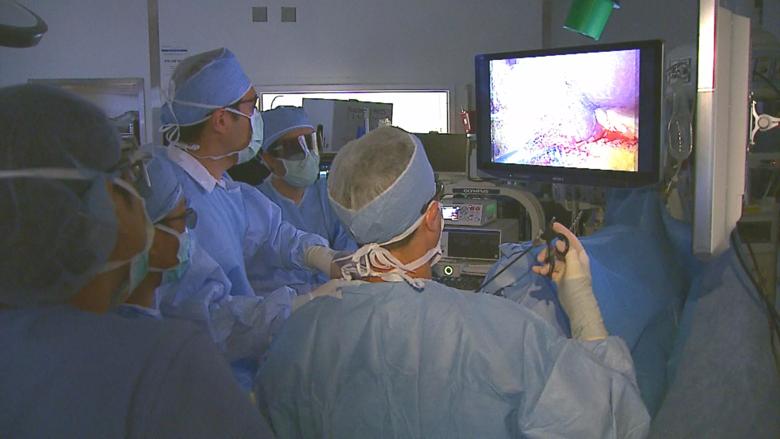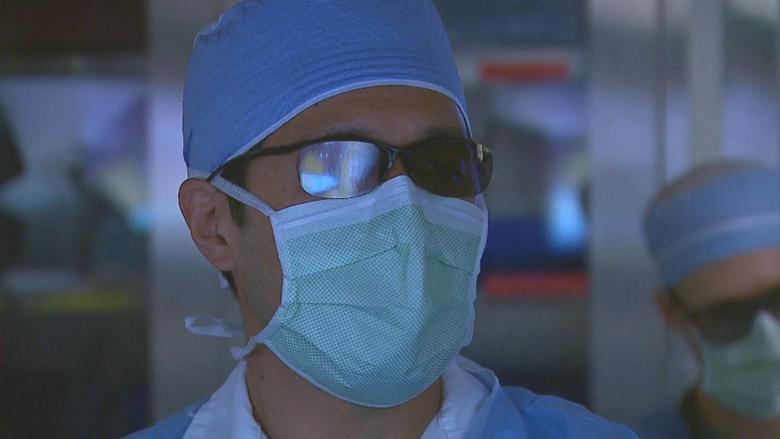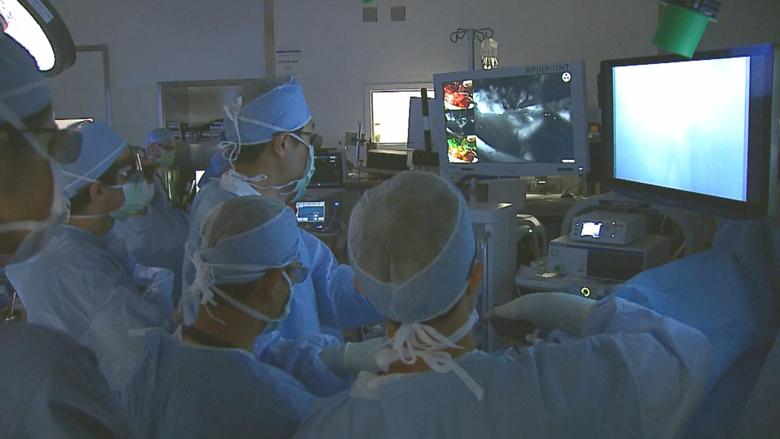Goal of procedure is to improve recovery of living donors, which may encourage more donations
images: 6
video: 3
audio: 0
text: 0
Content is property of Cleveland Clinic and for news media use only.


Cleveland Clinic has successfully performed the Midwest’s first purely laparoscopic living donor surgery for liver transplantation in an adult recipient. The advanced procedure is available at only a few hospitals worldwide, and Cleveland Clinic is the second U.S. academic medical center to offer this approach for living donor liver transplantation.
Unlike open surgery that requires a large incision to access the liver, the laparoscopic procedure is performed with surgical tools and a camera inserted through a few half-inch holes in the abdomen of the living donor. Once the piece of the liver is dissected, the surgeon retrieves the graft through a small incision below the navel. The minimally invasive technique benefits the living donor, who experiences better postoperative recovery and a quicker return to normal life, less pain, smaller scars, and lower risk of an incisional hernia compared with traditional open surgery.
https://newsroom.clevelandclinic.org/wp-content/uploads/sites/4/2019/10/LDLT_Animation_WithText.mp4
About five percent of people who undergo a liver transplant receive the organ from a living donor who has made the altruistic decision to give up a portion of their liver to save someone else’s life. The liver is the only organ that can regenerate, which makes it possible for a living person to donate a portion of their liver. It can take six to eight weeks for a healthy liver to grow back to its original size.
On August 19, Choon Hyuck David Kwon, M.D., Ph.D., director of Laparoscopic Liver Surgery at Cleveland Clinic’s Digestive Disease & Surgery Institute, led a team of surgeons and nurses during the minimally invasive procedure that extracted a third of the liver from a 29-year-old living donor.
In an adjacent operating room, Koji Hashimoto, M.D., Ph.D., Cleveland Clinic’s director of Living Donor Liver Transplantation, and his team received the donated segment of the liver and performed the transplant in a 66-year-old recipient. Due to an irreversible liver disease called cryptogenic cirrhosis, the recipient was suffering from life-threatening complications and needed a liver transplant.
Dr. Kwon specializes in minimally invasive liver surgery and living donor liver transplantation. In 2013, he merged both areas of expertise and started performing purely laparoscopic living donor surgeries for liver transplantation in pediatric and adult recipients.
“The most important aspect of a living donor liver transplant program is the safety of the donor. We have strict selection criteria and standards in place to determine the best surgical approach for a given living donor – whether it is minimally invasive or open surgery. With the laparoscopic technique, the donor gets the benefits of minimally invasive surgery, resulting in shorter postoperative recovery time, less pain, better cosmetic results, and lower risk of an incisional hernia,” said Dr. Kwon.

With advances in surgery and technology, living donor liver transplantation has become as important as deceased donor liver transplantation to save patients who are suffering from liver diseases. At Cleveland Clinic, a multidisciplinary team conducts comprehensive living donor evaluations to ensure successful outcomes both in the living donor and recipient.
“Living donor liver transplantation can save sick patients before they become too ill for a transplant. Patients on the waiting list to receive a liver from a deceased donor experience serious symptoms of chronic liver disease that affect their function and quality of life. If they identify a healthy living donor who is a good match with compatible liver anatomy, the surgery can be performed within a shorter waiting time. Living donor liver transplantation provides the best opportunity for patients in a timely manner,” said Dr. Hashimoto.
Statistics from the United Network for Organ Sharing show approximately 3,000 people die annually or become too sick while waiting to receive a liver transplant.
In addition to shorter waiting times, living donor liver transplantation provides numerous advantages for recipients. The quality of the liver is better, as living donors are healthy adults who have undergone a thorough medical evaluation. Also, because the operations on the donor and recipient take place at the same time, the period of ischemia (when the liver is without blood) is short – minutes, not hours. With advances in minimally invasive living donor surgery, the goal is to improve the recovery of living donors, which may encourage more individuals to participate in living donor liver transplantation.
Since the first case at Cleveland Clinic in August, Dr. Kwon and his team have successfully performed the purely laparoscopic procedure on four more living liver donors.
For more information about Cleveland Clinic’s Living Donor Liver Transplantation Program: clevelandclinic.org/livingdonation
To learn more about the evolution of the procedure and how Cleveland Clinic prepared for the first case, read First Purely Laparoscopic Living Donor Hepatectomy for Liver Transplant is a Landmark for Cleveland Clinic






Slide 1/6
Cleveland Clinic is a nonprofit multispecialty academic medical center that integrates clinical and hospital care with research and education. Located in Cleveland, Ohio, it was founded in 1921 by four renowned physicians with a vision of providing outstanding patient care based upon the principles of cooperation, compassion and innovation. Cleveland Clinic has pioneered many medical breakthroughs, including coronary artery bypass surgery and the first face transplant in the United States. Cleveland Clinic is consistently recognized in the U.S. and throughout the world for its expertise and care. Among Cleveland Clinic’s 82,600 employees worldwide are more than 5,786 salaried physicians and researchers, and 20,700 registered nurses and advanced practice providers, representing 140 medical specialties and subspecialties. Cleveland Clinic is a 6,728-bed health system that includes a 173-acre main campus near downtown Cleveland, 23 hospitals, 280 outpatient facilities, including locations in northeast Ohio; Florida; Las Vegas, Nevada; Toronto, Canada; Abu Dhabi, UAE; and London, England. In 2024, there were 15.7 million outpatient encounters, 333,000 hospital admissions and observations, and 320,000 surgeries and procedures throughout Cleveland Clinic’s health system. Patients came for treatment from every state and 112 countries. Visit us at clevelandclinic.org. Follow us at x.com/CleClinicNews. News and resources are available at newsroom.clevelandclinic.org.
Editor’s Note: Cleveland Clinic News Service is available to provide broadcast-quality interviews and B-roll upon request.